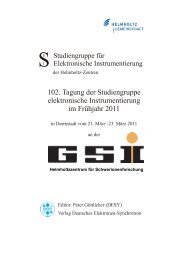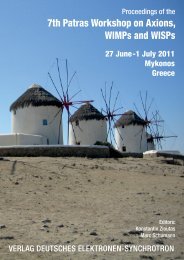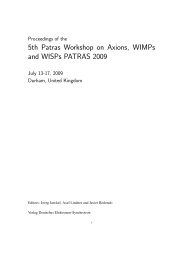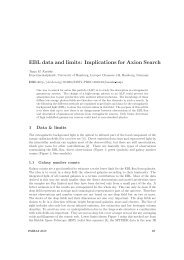Hamburg Neutrinos from Supernova Explosions ... - DESY Library
Hamburg Neutrinos from Supernova Explosions ... - DESY Library
Hamburg Neutrinos from Supernova Explosions ... - DESY Library
You also want an ePaper? Increase the reach of your titles
YUMPU automatically turns print PDFs into web optimized ePapers that Google loves.
CHRISTIAN OTT, EVAN P. O’CONNOR, BASUDEB DASGUPTA<br />
small regions of the needed (ρ, T, Ye) space (see the discussions in [47, 52]).<br />
A stringent constraint on the nuclear EOS is set by precision mass measurements of neutron<br />
stars in binary systems. The 2-M⊙ ([1.97 ± 0.04] M⊙) neutron star of Demorest et al. [43] rules<br />
out a large range of soft hadronic, mixed hadronic-exotic, and strange-quark matter EOS [3, 53].<br />
Recently, Hebeler et al. [49] have carried out chiral effective field theory calculations of<br />
neutron-rich matter below nuclear saturation density, strongly constraining the P (ρ) relationship<br />
in this regime. They derived a radius constraint for a 1.4-M⊙ neutron star of 10.5 km �<br />
R � 13.3 km (these numbers would be shifted up by ∼400 m if a detailed crust treatment was<br />
included) by requiring that all EOS support neutron stars with mass � 2 M⊙ and pass through<br />
the P (ρ) range allowed by their calculations.<br />
Steiner et al. [51] and Özel et al. [50] analyzed observations <strong>from</strong> accreting and bursting<br />
neutron stars to obtain neutron star mass-radius constraints. Such observations and their<br />
interpretations should be taken with a grain of salt, since large systematic uncertainties are<br />
attached to the models that are required to infer mass and radius and to the assumptions made<br />
in their statistical analysis. For example, [51] and [50], starting with different assumptions,<br />
derive rather different 2-σ mass-radius constraints <strong>from</strong> the same set of sources.<br />
In Fig. 1, we contrast the various observational constraints on the neutron star mass and<br />
radius with a range of EOS used in core-collapse supernova modeling. The LS family of EOS is<br />
based on the compressible liquid droplet model [18], while all other EOS (drawn <strong>from</strong> [44–48])<br />
are based on relativistic mean field (RMF) theory. The details of the M − R curves depend<br />
on multiple EOS parameters such as nuclear incompressibility, symmetry energy and their<br />
derivatives and we must refer the reader to [47] and to the primary EOS references for details<br />
for each EOS. Fig. 1 shows that none of the current set of available EOS allow for a 2-M⊙<br />
neutron star while at the same time being consistent with the current mass-radius constraints<br />
<strong>from</strong> observations. The crux is that the EOS needs to be sufficiently stiff to support 2-M⊙<br />
neutron stars and at the same time sufficiently soft to make neutron stars with moderate radii<br />
in the canonical mass range. This balance appears to be difficult to realize. The stiff set of<br />
RMF EOS produce systematically too large neutron stars. The soft compressible liquid-droplet<br />
LS180 EOS [18] agrees well with the mass-radius constraints, but is ruled out by its failure to<br />
support a 2-M⊙ neutron star. Closest to satisfying all constraints are the LS220 EOS of [18]<br />
and the yet unpublished HSDD2 EOS of [48] based on the RMF model of [54].<br />
The stiffness of the nuclear EOS at high and intermediate densities has important consequences<br />
for the postbounce evolution of core-collapse supernovae. In simple terms: the stiffer<br />
the EOS, the more extended the protoneutron star and the larger the radius and the lower the<br />
matter temperature at which neutrinos decouple <strong>from</strong> the protoneutron star matter. Assuming<br />
a Fermi-Dirac spectrum with zero degeneracy, the mean-squared energy of the emitted neutrinos<br />
is approximately given by 〈ɛ 2 ν〉 ≈ 21T 2 ν [55], where Tν is the matter temperature (in units of<br />
MeV) at the neutrinosphere (where the optical depth τ ≈ 2/3). Hence, a softer EOS will lead<br />
to systematically harder neutrino spectra than a stiffer EOS (as born out by the simulations of<br />
[17]). Since the charged-current neutrino heating rate Q + ν scales ∝ 〈ɛ 2 ν〉, a soft EOS leads to a<br />
higher neutrino heating efficiency than a stiff EOS. This is at least part of the explanation why<br />
some published 2D simulations using the soft, now ruled-out LS180 EOS have shown neutrinodriven<br />
explosions [17, 22, 23] while simulations with stiffer EOS have generally failed to yield<br />
such explosions in stars more massive than ∼11 M⊙ [17, 19, 25].<br />
Proceedings 26 of HAνSE 2011 HAνSE 2011<br />
5








